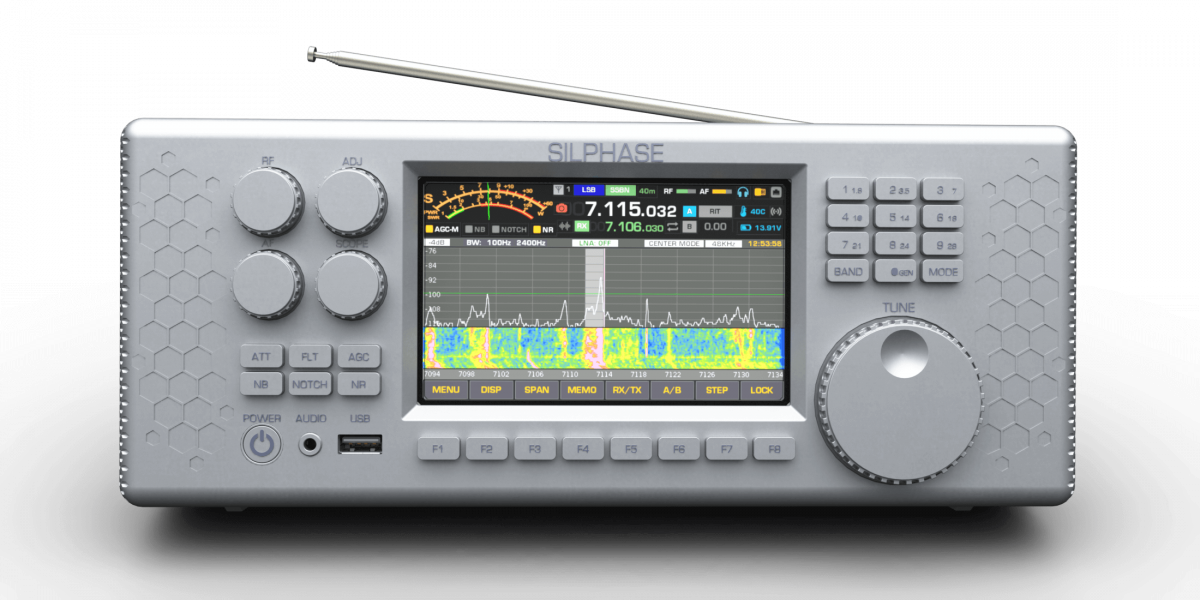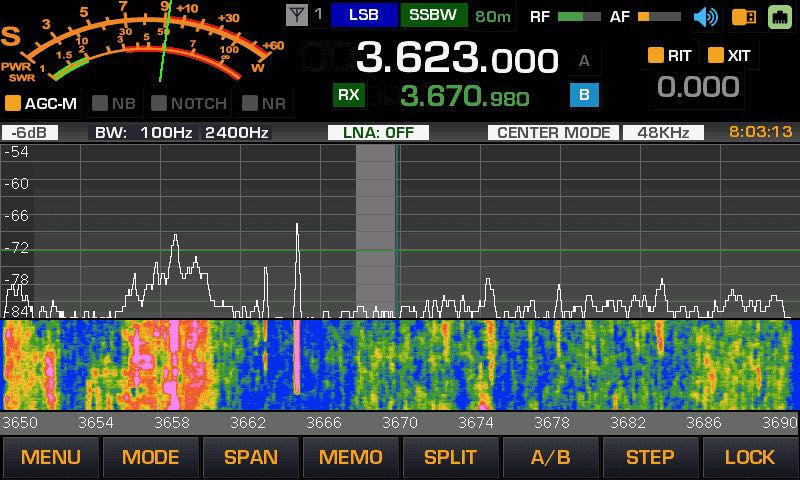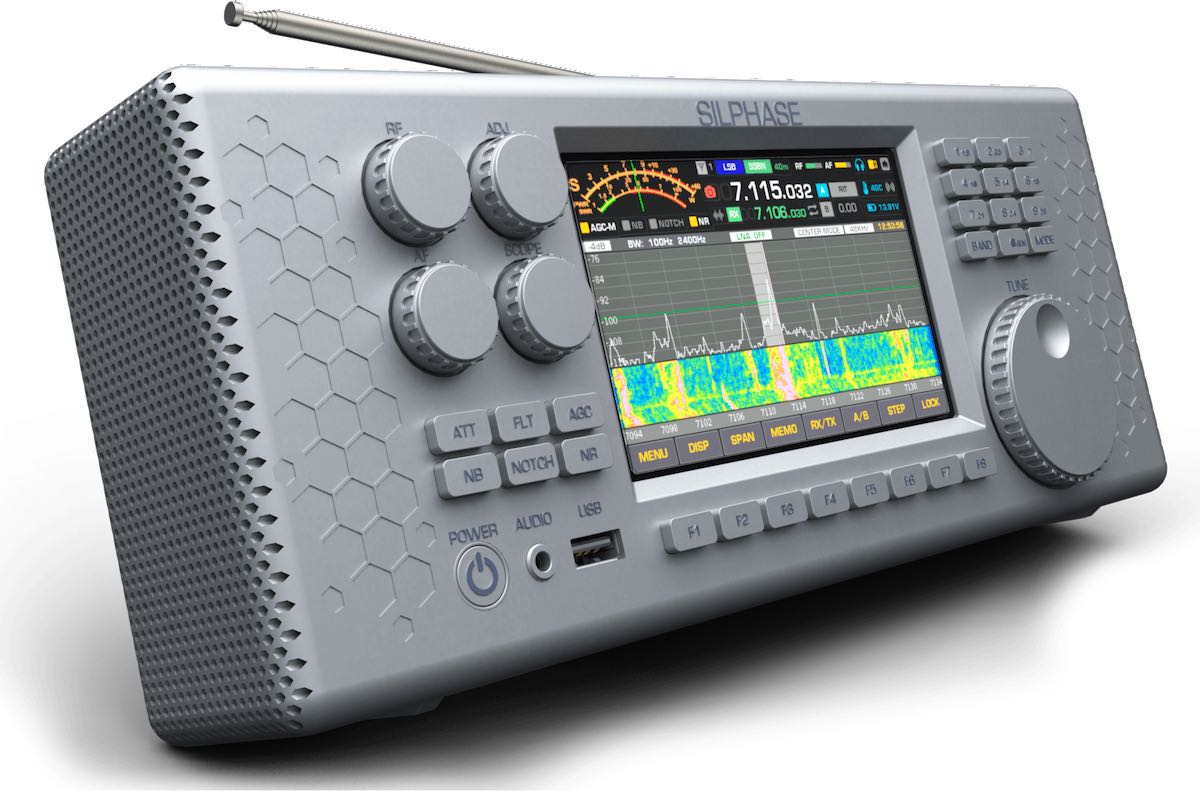
I’ve just learned about a new SDR receiver in development by the Polish company Silphase. It’s called the Silphase R1 and appears to be a stand-alone, high-performance SDR receiver.
What could set this receiver apart from the rest is the:
- Color backlit 5″ TFT touch screen display
- Magnesium alloy body/chassis
- USB out for recording and native logging
- Record to internal “flash memory” (unclear if audio and/or spectrum)
- Four internal speakers
- 12.6V 12000 mAh, internal battery
- IP55 rating for water/dust protection
- The price is $1199/€1099 with no expected availability date at time of posting
- Click here to download the PDF product brochure.
The receiver is portable and will measure 11.25×4.3×2.2in (285×110×55mm). Looks like the screen will be 5″ which should allow for a detailed spectrum viewing area (for comparison, the Icom IC-7300 TFT display is 4.3″)
Siphase is a new company based in Poland and they claim they also plan to eventually produce transceivers:
“At the end of 2020 we will introduce a 25W transceiver in the same form factor powered by an internal battery, and a bit little later a 100W transceiver in the same form factor also powered by an internal battery.”
The Silphase product page has a complete list of specifications, but here are some worth noting:
- Frequency coverage RX 0.1–30MHz
- Frequency resolution 1Hz
- Frequency steps 1Hz to 1KHz
- Dual VFO
- Direct sampling 16bit high speed 122 M/s ADC
- Modes: CW, SSB, AM, FM
- Sensitivity 1.8–29.999MHz, SSB/CW: (BW: 2.4kHz at 10dB S/N) – 132 dBm, 0.06?V
- 20dB LNA
- Spurious and image rejection >90 dBm
- Clipping level -3dBm
- DSP (various filters, adaptive noise reduction, automatic notch filter, notch blanker, adjustable filters (0-1KHz HPF,0.5-6KHZ LPF, 50Hz step, etc.)
- AGC (slow, medium, fast)
- Main filter sharpness Factor 1.05 and lower
- Audio recorder (use the internal flash memory or USB 16GB external flash memory)
- Virtual USB audio card for OS update
- Ham radio hardware log
- OS QNX (“UNIX-like” real time operating system)
- Telescopic antenna with F connector
- Main optical encoder and four multifunction encoders
- 6 input modes buttons (attenuators, adjustable filters, AGC, NB, auto notch filter, NR)
- Power supply requirement 12.6 DC ±15%
- Power consumption RX 0.6 A typical
- Battery 12000 mAh, 12.6V (3×3.7V/12000 mAh)
- Operating time 20 Hours
- Operating temperature range –10C to +60C; 14F to 140F
- Frequency stability Less than ±0.2ppm (–10?C to +60?C; 14?F to 140?F)
- Dimensions (W×H×D) 285×110×55mm; 11.25×4.3×2.2in
- Weight (approximately) 1.8kg; 4 lbs
- Magnesium alloy body, IP55 (in future IP 67)
- “Expected Operational Lifetime 30 Years” With One Year Warranty – Additional Warranty
- Made in EU
As I learn more about this receiver and the company producing it, I’ll post updates with the tag: Silphase R1
Click here to check out the Silphase website.
Do you enjoy the SWLing Post?
Please consider supporting us via Patreon or our Coffee Fund!
Your support makes articles like this one possible. Thank you!




I think many of these SDR receiver designers are stuck on their own planet with only their ideas of what makes a good SDR receiver, yet they misses so many bases.
If they are going to build a decent SDR, put on a decent connector like N or BNC, even the humble SO239 is better than that crappy SMA connector that every serves up.
Then lets talk about the basics. Direct access to the mode, volume, preamp/gain, multiple antenna selection, attenuation, BIAS voltage to antenna port 5 volts to 24 variable. Mhz, Kilohertz, hertz step changes putting these things in a menu while saving money then you might as well make it a black box receiver.
Then lets talk about filter bandwidths, 6, 9 20, and 40 and 120khz for future digital modes and things like EMC measurements. Then lets get to another thing the S-meter which is done in firmware, S-meter 50uV S9, Dbm, Quasi peak, RMS Average also with the ability to apply correction factors so you can use the accurate S-meter for loss and emc measurements. Dont use standard Dbuv Emf that is not used in industry or anyone with common sense!
Then lets talk about the spectrum plot and colors. Make it behave more like a spectrum analyzer with markers and trace save memories. An ability to plot signal strength to mutiple traces that is tied to antenna switch position that can be consolidated to one save image to show difference with peak delta markers would be great.
Then if they decided to use batteries, us common 18650 cells which are available everywhere and which can be charged via USB C.
Bandpass filters along with a band reject filter for the broadcas AM band should be mandatory.
Churning out yet another SR radio that does everything badly is not what the market wants, when are they going to get it?
Appears to be inspired by or cloned from Konstantin’s EPMAK transceiver? http://www.cqham.ru/forum/showthread.php?35581
Interesting. I wonder if Konstantin has been working with them. The similarity is striking.
I can’t see any mention of the ability to connect a monitor to the receiver?
That 5 inch screen is a little limiting.
I’ve emailed Silphase asking the question.
If you hear back from them, please follow-up. 🙂
Very interesting, could do with less plastic ? case looks like it came out of a 3D printer, probably did, nothing wrong with it but the case is as important but the emphasis is of course on the screen.
It would be nice if the buttons lit up.
It’s obvious it’s a lithium battery, 3 X 3.7 volts, that would be the nominal voltage of Lithium and it’s great to finally see a radio with a proper battery, Icom missed a good opportunity here and opted instead to use pathetic 7.2 volts in this day and age in such an expensive radio, it’s a joke.
I can get several hrs use out of 8.4 Ah LiFeP04 using my FT-891 at 100 watts.
No tuner is a shame, this would really have been great, yes I know, bring a resonant antenna etc but there are times the antenna might not be resonant on some bands and then you hear a signal and you wished you had brought your external tuner so it would be nice to have it built in or at least have the option like the Kx3.
All the Bling but how will it perform, what’s the audio like ? currently the benchmark radio for audio for me is my FT-891 even with the preamp on it’s got a really quiet receiver that sounds really good via headphones and it sounds better than my IC-7300 too which has this harshness in the audio that is fatiguing and the same can be said for my Xiegu G90, perhaps it’s SDR related but I prefer the audio from the FT-891, it’s an amazing radio, no fancy waterfall but this doesn’t allow me hear better.
Still the Silphase R1 is a very cool concept, I love the form factor and if they can manage 100 Watts like they say that would be amazing, but I imagine they’d have to have some form of cooling, even a metal case which I think would look better, like the Xiegu X5105 ? I’d like to see them bring out the 100 watt version first.
I like it more than the IC-705, I don’t need bluetooth, wireless, GPS VHF/UHF D-Star……… and I’d like more than 5 watts on battery lol.
oops I just read it again “Magnesium alloy body/chassis” pity I can’t edit my post, that would be nice lol.
Different colour options would be cool.
Good notes. To be clear, from my understanding the R1 is their first product and will be a receiver only (hence, the lack of tuner). If this is a success, they plan to build a low power transceiver with the same form-factor. A 100 watt radio would be after that and I seriously doubt it would be the same size for the reasons you mention.
I’ve actually sent a request to the company and perhaps I can get one of their team to answer comments here. I don’t know them at all, so not sure if I’ll have any success.
I am interested, but why stop at 30MHZ? Why can’t you get all the HAM band’s and go up to 999MHZ? Sorry to sound ungrateful.
I need you help here,
What use for 4 speakers?
How “Supreme sound” can it be if it’s for HF NB modes after all?
For layman it looks as 100Mpix smartphone camera over 10Mpix reasonable one.
I’m purely guessing here, but in my head I imagine they’re using four smaller speakers like those used in a number of compact portables. Perhaps together they produce a more robust sound. I, for one, welcome a radio with robust audio. If this unit comes to fruition, the audio would be one of the first things I check.
If I spend that kind of money, I’ll buy an Icom, Yaesu, or Kenwood with TX included. Too much money for that radio.
I have to admit that the price point is awfully high for most radio enthusiasts these days. It really would have to offer something above and beyond and that remains to be seen. I know DXers who would drop a chunk of change on a portable SDR with built-in recording if it had benchmark receiver specs.
The four speakers sounds suspect to me.
Also it’s a bad idea to use onboard flash memory to record.
Would only last about 2 to 5 years of used that way.
The two points alone make me suspicious, or the designers have made two errors of judgement.
I don’t know, but I suspect the “flash memory” is a removable SD or MicroSD card.
More vaporware by SWLING… Seriously, after all the previous fakeware and vaporware radios swling.com has promoted, how do you guys considering swling.com to be a source of anything?
Thomas, I suggest you block this troll.
Sorry you feel that way, Pat. Good thing there are so many other radio sites you can check out. Not forcing you to stay here.
When I discover a product announcement I like, I post it. It’s sort of that simple. 🙂
Cheers,
Thomas
Amen Thomas.
Well, I consider SWLing.com to be the preeminent source of information for radio hobbyists…..seriously. Keep up the excellent work Thomas.
Thank you, Mario!
Hopefully more like lithium polymer or similar instead of a standard li-ion batteries, especially if talking about transceiver versions in the same size format.
Battery choice aside, opting for QNX is an upgrade from Android or a basic off-the-shelf Linux embedded solution IMO. QNX is considered one of the more reliable POSIX-compliant operating systems available. It is used in a variety of embedded realtime and even mission critical roles ranging from consumer to industrial commercial roles.
Of note, I even used QNX as a desktop OS for awhile back in the day.
Those four knobs in the upper-left corner sure look way too close to each other! Even just a quarter-inch additional spacing vertically & horizontally would be ergonomic. Otherwise, I really like the understated look of this receiver…rather classy in my opinion.
I thought the exact same thing about those four knobs when I saw the image the first time, Guy! I’m impressed someone added four speakers to an HF receiver! 🙂
Looks very intriguing.
Like Bill Lee says, those Lithium batteries will need to be easily changed with an option for external power, if it is to claim a 30 year life span.
Four speakers – could make for a very nice room filling sound.
Agreed. The battery must be Lithium and I should hope user-replaceable. 🙂 I’m very pleased they’ve added four speakers! Let’s hope it has an ample audio amp for those. I look forward to hearing it.
Do we suspect that the battery is a Li-ion battery? Can we assume it is easily removable?
Will there be a socket for external “battery power”?
“4 internal speakers” ??